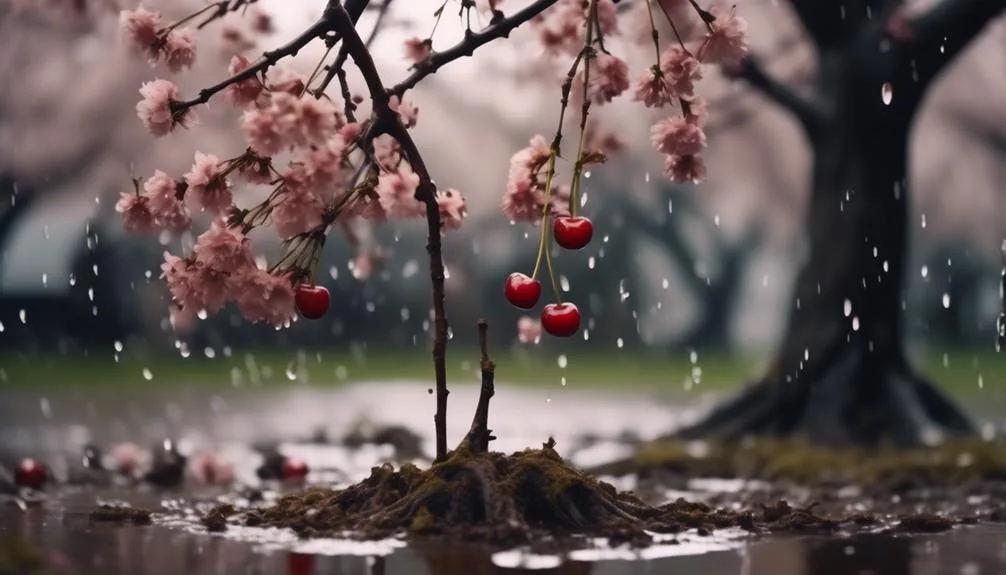Curious about whether cherry trees can handle wet soil? Amidst your garden's lush greenery, conflicting opinions may leave you puzzled.
Understanding the ins and outs of cherry tree cultivation holds the key. Let's explore if these resilient trees can thrive in wet soil and learn strategies for their survival in less-than-ideal conditions.
Ideal Soil Conditions for Cherry Trees
To ensure healthy and thriving cherry trees, it's essential to provide them with well-draining, loamy soil that's rich in organic matter.
Cherry trees have specific nutrient requirements for optimal growth. They benefit from soil that's rich in nitrogen, phosphorus, and potassium. These nutrients support the development of strong roots and help the tree to establish itself firmly in the ground.
Additionally, cherry trees require a pH level between 6.0 and 6.8 for ideal growth. This slightly acidic soil allows for better nutrient absorption and supports root development.
When selecting a location for planting cherry trees, it's important to consider these soil conditions to ensure that the trees receive the necessary nutrients for healthy growth and abundant fruit production.
Challenges of Wet Soil for Cherry Trees
Dealing with wet soil presents significant challenges for cherry trees, affecting their overall health and productivity. When cherry trees are exposed to excessive moisture, they're prone to root rot, a fungal disease that thrives in waterlogged soil. This can lead to a decline in the tree's overall health and even death if not addressed promptly.
Additionally, drainage issues in wet soil can cause oxygen deprivation to the roots, leading to stunted growth and decreased fruit production. The excess water also creates an environment where harmful pathogens can thrive, further compromising the tree's health.
To ensure the optimal growth of cherry trees, it's crucial to address these challenges posed by wet soil through proper soil management and drainage solutions.
- Root rot
- Oxygen deprivation
- Pathogen proliferation
Strategies for Cherry Trees in Wet Soil
Consider implementing raised beds to improve drainage and mitigate the challenges of wet soil for your cherry trees. Raised beds can significantly reduce the negative impact of waterlogged soil and provide a more suitable environment for your cherry trees to thrive.
Additionally, consider using disease-resistant cherry tree varieties that are better adapted to wet conditions, such as Montmorency or Rainier.
When it comes to pruning techniques, focus on maintaining good air circulation within the tree canopy to reduce the risk of fungal diseases that thrive in damp environments. Regularly prune out dead or diseased branches and thin the canopy to allow sunlight and air to reach the inner parts of the tree.
Best Cherry Tree Varieties for Wet Soil
Select cherry tree varieties with natural tolerance to wet soil conditions to ensure successful growth and bountiful harvests in your garden. When choosing cherry tree varieties for wet soil, consider the following options:
- Black Tartarian: This variety is known for its high tolerance to wet soil conditions and produces delicious, dark cherries.
- Bing: Bing cherry trees are also suitable for wet soil and offer sweet, juicy fruit for your enjoyment.
- Stella: Stella cherry trees are resilient in wet soil and produce flavorful, dark red cherries perfect for snacking or baking.
When planting cherry trees in wet soil, proper maintenance is crucial. Ensure adequate soil drainage, provide regular cherry tree maintenance, and select the right cherry tree varieties to thrive in wet soil conditions.
Tips for Maintaining Cherry Trees in Wet Soil
To ensure the health and productivity of cherry trees in wet soil, it's essential to implement proper maintenance practices that promote optimal growth and fruit production. Here are some tips to help you maintain your cherry trees in wet soil:
| Pruning Techniques | Disease Resistance |
|---|---|
| – Prune cherry trees during their dormant season to remove dead or diseased branches and improve air circulation. | – Select cherry tree varieties known for their resistance to common diseases in wet conditions, such as bacterial canker and root rot. |
| – Avoid heavy pruning during the growing season to prevent excessive water uptake and susceptibility to fungal infections. | – Apply organic fungicides preventatively to protect cherry trees from fungal diseases that thrive in wet soil. |
| – Properly dispose of pruned branches to prevent disease spread and maintain a clean growing environment. | – Monitor cherry trees regularly for signs of disease and treat promptly to prevent further spread. |
Conclusion
In embracing the right strategies and cherry tree varieties, thriving in wet soil is certainly possible. By addressing the challenges and selecting suitable varieties, cherry trees can flourish despite less than ideal conditions.
With careful maintenance and attention, the beauty and fruit of cherry trees can be enjoyed, even in wet soil. This underscores the resilience and adaptability of nature, offering a refreshing perspective on cultivating thriving ecosystems in various environments.

My interest in trees started when I first saw the giant sequoias in Yosemite.
I was a teenager then, and I remember thinking, “I need to learn more about this.”
That moment stuck with me.
A few years later, I went on to study forestry at Michigan Tech.
Since graduating, I’ve worked in a mix of hands-on tree care and community education.
I’ve spent over ten years helping people understand how to plant, maintain, and protect the trees in their neighborhoods.
I don’t see trees as just part of the landscape.
They are living things that make a real difference in our daily lives.
